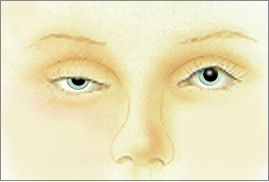
Drooping Eyelids: What is it?
Symptoms You May Experience:
Examination: What Your Eye Doctor Will Look For:
What You Can Do:
When To Call Your M.D.:
Treatment:
Prognosis: Will I See Better?
Besides being a cosmetic problem, drooping upper eyelids can block upward vision and, if the eyelids are low enough, even central vision. In the case of nerve problems that result in drooping upper eyelids, ptosis can be a sign of a more serious neurologic problem. In infants, drooping upper eyelids can cause amblyopia (poor visual development) by blocking central vision or causing astigmatism which distorts the vision.
If your upper eyelids droop, you may notice that your eyelids block your vision when you look upward or even straight ahead. You may have trouble reading, because your eyelids may droop even more when you are looking down at a book. You may notice forehead tension headaches if you lift your eyebrows with your forehead muscles to help raise your upper eyelids. If your ptosis has a neurologic cause, one upper eye lid may droop more than the other, the droopiness may fluctuate (often becoming worse later in the day), or you may experience double vision.
Your eye doctor will ask questions about how long your upper eyelids have drooped and if the droopiness fluctuates, as well as if you have any muscle or nerve diseases that could cause the droopiness. He or she will measure your eyelid position and test how far you can raise your upper eyelids and if your can close your eyes completely. Your pupils, eye movements, and peripheral vision will also be checked.
Besides avoiding injury to the upper eyelid and its muscle, there is no way to prevent ptosis from developing.
If your upper eyelids droop and block your vision, see your ophthalmologist to discuss treatment options. You should see your ophthalmologist especially promptly if the ptosis is present in an infant or child, is new or fluctuates, or is accompanied by unequal pupils or double vision. If the ptosis occurs along with new weakness in other muscles, or difficulty breathing, swallowing, or speaking, go to your local emergency room immediately.
The treatment of drooping upper eyelids usually involves surgery in the operating room or minor operating room to repair the droopiness. Your ophthalmologist will choose a surgical technique depending on the amount of ptosis and the function of the muscle that lifts the upper eyelid. Most ptosis repairs are performed with numbing injections, in some cases general anesthesia may be necessary. The ophthalmologist will place stitches to closeyour eyelid incisions during surgery, these stitches will be removed about 1 week after the operation.
Most ptosis surgeries are successful. Some patients require more than one surgery to fully correct the ptosis, since it can be difficult to judge the position of the eyelid when the patient is under anesthesia in the operating room.
Drooping upper eyelids, known as ptosis, can occur at birth, or more commonly in adulthood. Newborns with ptosis usually have underdevelopment of the muscle that lifts the upper eyelid, while adult ptosis has a variety of causes. The most common cause is age-induced stretching of the muscle that lifts the upper eyelid, but injury, muscle diseases, or nerve diseases of the muscle or upper eyelid are also potential causes of ptosis.
Above: Ptosis (Click For Bigger View)
Contact Lenses | Glaucoma | Just For Fun | Eyeglasses | Eye Doctor | Eye Care And Symptoms | Eye Anatomy | Online Eye Tests | Laser Eye Surgery | Laser Eye Surgery Directory: Canada | Laser Eye Surgery Directory: USA | Laser Eye Surgery Reviews | Submit A Review | Contact Us | Privacy Policy | Sitemap
Copyright 2006-2009 Vision Health


